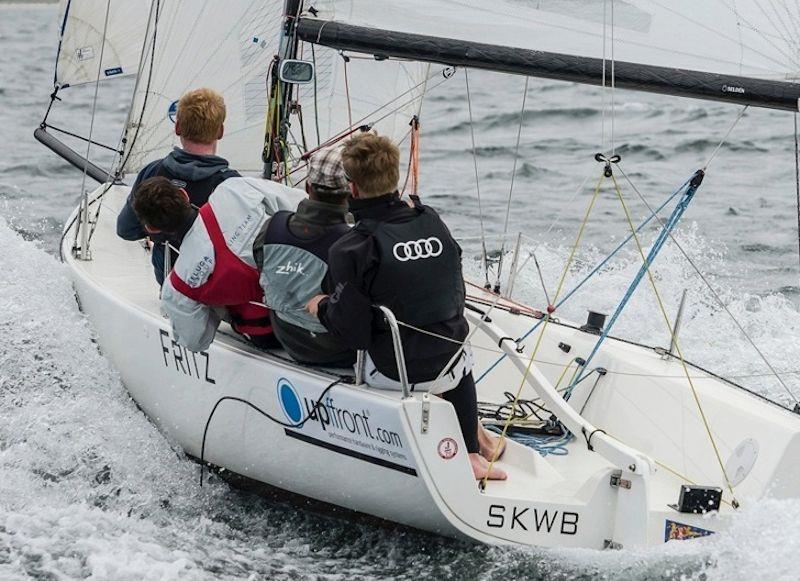
J/70 Running Rigging
by Diego Sosa, Upffront 19 Sep 2018 08:30 BST

The J/70 sportsboat © upffront.com
Upffront.com has supplied many running rigging packages for top level J70 campaigns. Find out what is currently "hot" when it comes to driving the best performance out of these exciting sportsboats.
N.B. These recommendations, based on Gottifredi Maffioli's full range, apply to any small performance sportsboat from 23-27ft. Note: there is a J70 class rule minimum diameter of 6mm for all primary sheets and halyards.
Halyards
Main - DSK78 Race POLY (6mm)
The SK78 core provides excellent strength and stiffness and as the main is cleated off, it has no special cover requirements and the H.T. polyester cover is more than adequate. We recommend a soft LOOP shackle for attachment to the head of the main.
Jib - DSK78 Ultra (6mm)
The jib halyard is effectively a strop with a spliced eye at both ends and therefore the single braid Ultra 78 offers the maximum strength/stiffness for minimum weight. A soft LOOP shackle attaches the head of the jib and the tail end exits the mast when fully hoisted and attaches to a 4:1 purchase for tensioning. A lightweight, 5mm polyester cover-only line is used as a hoist line for the main Ultra 78 halyard strop.
Gennaker - DSK78 Race DYCO (6mm)
Again, the DSK78 core provides performance level strength and stiffness but this line requires a cover which has excellent grip and abrasion resistance to ensure solid holding in the cleat and minimises wear at the masthead. The Dyneema® + Cordura® of the DYCO cover provides this, together with low weight. A ball is used at the top end to prevent jamming in the masthead sheave.
Sheets
Main - Swiftcord (8mm)
Swiftcord is a great line for any sheet or control line that is constantly handled, due to its excellent handling / comfort. It is a single braid made from Dyneema® and non-slip fibres which makes it soft but grippy, extremely lightweight and durable.
Jib - Superswift (8mm)
Superswift is a double braid line with an SK78 core and Dyneema® + non-slip fibre cover which is easy to taper. The jib sheet is continuous, and we recommend the use of 8mm to ensure a good grip and comfortable handling. However, the sail ends can be tapered down to save weight. The core of the 8mm Superswift is 5mm and so an additional 2mm, SK78 single braid is added to the core to maintain the class minimum diameter requirement. The ends of the jib sheets go through a block on the clew and back down to the jib car to provide a 2:1 purchase.
Gennaker - Superswift (8mm)
The gennaker sheet is identical in construction to the jib sheet with obviously longer tapers. The ends are terminated in small eyesplices and the sheets are attached to the clew with a single strop (approx. 300mm long) to minimise snagging as it is dragged around the forestay.
Backstay
Upper - Ultrawire 99 (6mm)
With the introduction of Dyneema® SK99 there is no sportsboat in the world that should be using wire backstays any more! Gottifredi Maffioli's Ulrawire 99 has a core of SK99 with a very tight, long angle Dyneema® SK78 braid which creates a super stiff and durable backstay which is much kinder to your mainsail leech. On the J70, the single Ultrawire backstay is attached to the mast crane with a soft eye splice with a lash thimble at the lower end.
Lower - DSK78 Ultra (6mm) + DSK78 Race POLY (6mm)
For the signature J-boat backstay purchase system, upffront.com recommends a strop of DSK78 Ultra single braid with a control line of 6mm Race POLY. Simple but effective.
Control lines
Main traveller - Swiftcord (5mm)
The traveller sees constant adjustment upwind and needs to be stiff but comfortable. The 5mm Swiftcord is adequate for the job but some clients prefer 6mm to improve handling.
Kicker - Superswift (6.5mm)
The 6.5m Superswift provides that little bit extra stiffness over the alternative 6mm Swiftcord in this critical application. With a swivelling cleat on either side of the coach roof, the Dyneema® + non-slip cover provides excellent handling, grip and durability. Floating blocks at the mast base are attached with a DSK78 Ultra single braid strops.
Gennaker tack-line - Superswift (8mm)
A tapered 8mm line provides comfortable handling with good grip in the cleat plus lightweight. An eye splice with a soft LOOP shackle attaches to the tack of the gennaker and a ball is used to prevent jamming at the pole end.
Pole out - Superswift (6.5mm)
Summary
Halyards - SK78 core throughout provides strength, stiffness and responsiveness required for this performance sportsboat.
Sheets and control lines - a combination of Superswift, for tapered lines or where additional stiffness is required, and Swiftcord for ropes which need an additional level of comfort
To learn more about running rigging, check out our free guide at upffront.com.